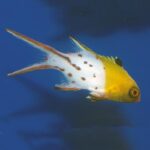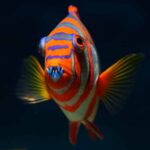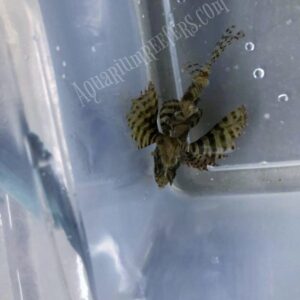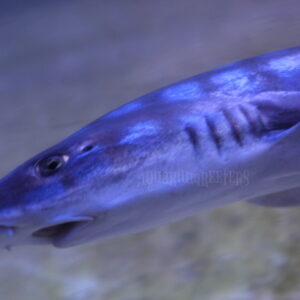Description
The Spanish Hogfish (Bodianus rufus) is a beautiful and vibrant fish with a maximum size of around 12 inches (30 cm). It has a robust body shape and a distinctively elongated snout. The body colouration can vary, but it is typically yellowish orange with blue and purple head.
Taxonomy
The Spanish Hogfish belongs to the genus Bodianus and the family Labridae. The Labridae family, also known as wrasses, is a diverse group of marine fish known for their vibrant colours and intricate patterns. The closest relatives of the Spanish Hogfish within the Bodianus genus include other hogfish species such as the Cuban Hog (Bodianus pulchellus) and the Lyretail Hog (Bodianus anthioides).
Natural Habitat
In their natural habitat, Spanish Hogs are found in rocky areas and coral reefs. They prefer areas with abundant hiding spots and crevices where they can seek shelter. These fish are typically encountered at depths ranging from 10 to 100 feet (3 to 30 meters).
Keeping Spanish Hogfish Healthy:
The Spanish Hog requires a moderate level of care and is considered suitable for intermediate aquarists. Providing a well-maintained aquarium with stable water parameters is essential for their health. Ensure a proper filtration system and regular water changes to maintain excellent water quality.
Special Requirements and Feeding
Spanish Hogfish are omnivorous and should be offered a varied diet consisting of high-quality marine-based foods, including pellets, flakes, frozen or live foods such as brine shrimp, mysis shrimp, and chopped seafood. Supplement their diet with vegetable matter like algae or spirulina flakes.
How Many Should I Keep?
It is recommended to keep only one Spanish Hogfish per aquarium to minimize aggression and territorial disputes. They can become aggressive towards similar-looking fish or other hogfish species.
Lighting Preference
The Spanish Hog does not have specific lighting requirements and can adapt to a wide range of lighting intensities. Providing moderate lighting levels in the aquarium is sufficient.
Suitable Tank Mates
When selecting tank mates for the Spanish Hogfish, it is important to choose fish that are of a similar size and temperament. Avoid keeping them with small, delicate fish or invertebrates that may be targeted as potential prey or subjected to aggression.
Reproduction in the Wild
The Spanish Hogfish (Bodianus rufus) reproduces through a process known as broadcast spawning. During spawning, male and female Spanish Hogs release their eggs and sperm into the water column simultaneously. This synchronised release increases the chances of successful fertilization. Once fertilized, the eggs develop into larvae that drift in the water column.
Breeding Bodianus rufus:
- Set up:
Breeding Spanish Hogs in captivity requires a spacious aquarium with appropriate hiding spots and live rock structures. Maintain excellent water quality with stable parameters, including a temperature range of 75-82°F (24-28°C) and a salinity level of 1.023-1.025.
- Courtship/Spawning:
In the wild, Spanish Hogfish engage in courtship behaviours before spawning. Males display vibrant colours and perform courtship dances to attract females. Courtship displays may involve rapid swimming, fin movements, and changes in colouration. Once courtship is successful, the pair releases their gametes into the water column.
- Rearing:
Rearing Spanish Hog larvae is challenging due to their specific dietary requirements. The larvae require small, live food options such as copepods, rotifers, and finely powdered flake foods. Providing appropriate filtration and maintaining pristine water quality are crucial during the larval rearing phase.
Sexual Dimorphism
Sexual dimorphism in Spanish Hogfish is not pronounced. However, males may display more intense colouration and larger size compared to females. Males also tend to exhibit more territorial and aggressive behaviours during the breeding season.
Distribution
The Spanish Hogfish, Bodianus rufus, is naturally distributed in the western Atlantic Ocean, particularly along the coasts of Florida, the Bahamas, and the Caribbean. It can also be found in other regions of the Caribbean Sea. While there may be captive-bred or line-bred strains available, the original fish come from the wild populations in these areas.
Summary
The Spanish Hogfish, Bodianus rufus, is a vibrant and attractive fish species that adds beauty to marine aquariums. They can grow up to 12 inches (30 cm) in size and require a moderate level of care. Their natural habitat includes rocky areas and coral reefs, where they seek shelter and explore crevices. In terms of reproduction, These fish engage in broadcast spawning, releasing their gametes into the water column. Breeding them in captivity requires proper tank setup, courtship behaviours, and careful larval rearing. Spanish Hogs are not typically found as captive-bred or line-bred strains, with the original fish sourced from the wild populations in the western Atlantic Ocean. With their captivating appearance and active behaviour, These fish make a delightful addition to marine aquariums.
The Fish pictured here are representative only and the livestock you receive may vary in pattern, coloration, and shape.









Reviews
There are no reviews yet.